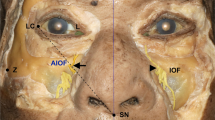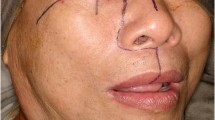The aim of the present work was to identify variants of the distribution and branching of the infraorbital nerve (ION) in the infraorbital canal. The Vorob’ev macromicroscopic method was used to prepare the heads of 23 people (11 male and 12 female) aged from neonatal to 74 years. The ION could divide into branches at the level of the inferior orbital fissure, at the beginning of the infraorbital groove, the infraorbital canal, the infraorbital foramen, and after emerging from the infraorbital foramen. Some preparations showed accessory infraorbital foramina though which branches of the ION passed. The nerve in 15 preparations consisted of one stem and divided into branches at the infraorbital foramen or 3–6 mm distal to it (magistral branching). Accessory foramina in most cases were round or flattened-round in shape. Data are presented on the different variants of the structure and topography of accessory infraorbital foramina.
Similar content being viewed by others
References
T. P. Kolesnikova, “x-Ray studies in trauma to the maxillofacial area in military personnel,” in: Organizational, Diagnostic, and Therapeutic Challenges in Emergency Conditions, Omsk Book Publisher, Omsk (2000), Vol. 2, pp. 317–318.
E. E. Lutsevich, “Refined indications for reconstruction of the orbit in fractures of its lower margin,” in: Proc. Int. Symp. Diseases, Tumors, and Traumatic Injuries to the Orbit, Western Division, Russian Academy of Medical Sciences, Moscow (2005), pp. 260–266.
E. I. Sidorenko, E. D. Gorbunova, M. V. Lekishvili, et al., “Results of the surgical treatment of traumatic injuries to the orbit in children,” Vestn. Oftalmol., No. 2, 41–42 (2005).
V. B. Shadlinskii, Topography and Intratruncal Structure of the Infraorbital and Inferior Alveolar Nerves: Auth. Abstr. Dissert. Cand. Med. Sci., Tbilisi (1982).
S. Canan, O. M. Asim, B. Okan, et al., “Anatomic variations of the infraorbital foramen,” Ann. Plast. Surg., 43, No. 6, 613–617 (1999).
E. H. Ference, S. S. Smith, D. Conley, and R. K. Chandra, “Surgical anatomy and variations of the infraorbital nerve,” Laryngoscope, 125, No. 6, 1296–1300 (2015).
S. Gozdziewsky, C. Nizankowski, and R. Kindlik, “Die morphologische Analyse des Canalis infraorbitalis und des Foramen infraorbitale beim Menschen,” Anat. Anz., 145, No. 5, 517–527 (1979).
K. S. Hu, H. H. Kwak, W. C. Song, et al., “Branching patterns of the infraorbital nerve and topography within the infraorbital space,” J. Craniofac. Surg., 17, No. 6, 1111–1115 (2006).
K. Hwang, S. J. Lee, S. Y. Kim, and S. W. Hwang, “Frequency of existence, numbers, and location of the accessory infraorbital foramen,” J. Craniofac. Surg., 26, No. 1, 274–276 (2015).
J. Nderitu, F. Butt, and H. Saidi, “Variations in emergence and course of the inferior palpebral nerve,” Craniomaxillofac. Trauma Reconstr., 7, No. 3, 233–236 (2014).
A. R. Rai, R. Rai, R. Vadgaonkar, et al., “Anatomical and morphometric analysis of accessory infraorbital foramen,” J. Craniofac. Surg., 24, No. 6, 2124–2126 (2013).
S. Suresh, P. Voronov, and J. Curran, “Infraorbital nerve block in children: a computerized tomographic measurement of the location of the infraorbital foramen,” Reg. Anesth. Pain Med., 31, No. 3, 211–214 (2006).
R. S. Tubbs, M. Loukas, W. R. May, and A. A. Cohen-Gadol, “A variation of the infraorbital nerve: its potential clinical consequence especially in the treatment of trigeminal neuralgia: case report,” Neurosurgery, 67, No.3, 315–316 (2010).
H. Wang, G. Liu, W. Fu, and S. T. Li, “The effect of infraorbital nerve block on emergence agitation in children undergoing cleft lip surgery under general anesthesia with sevoflurane,” Paediatr. Anaesth., 25, No. 9, 906–910 (2015).
Author information
Authors and Affiliations
Corresponding author
Additional information
Translated from Morfologiya, Vol. 150, No. 4, pp. 55–58, July–August, 2016.
Rights and permissions
About this article
Cite this article
Shadlinskii, V.B., Guseinov, B.M. & Mustafaeva, N.A. Branching Variants of the Infraorbital Nerve. Neurosci Behav Physi 47, 651–654 (2017). https://doi.org/10.1007/s11055-017-0450-y
Received:
Revised:
Published:
Issue Date:
DOI: https://doi.org/10.1007/s11055-017-0450-y




